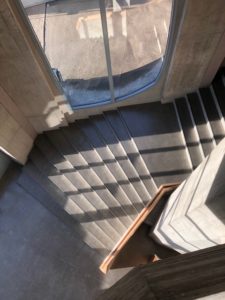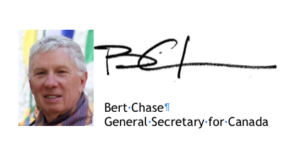26 Jan From the World Society – On Stairs, Doors and Windows
 Dear Members and Friends of the Anthroposophical Society in Canada,
Dear Members and Friends of the Anthroposophical Society in Canada,
During a series of autumn meetings, the gift of an uncommitted afternoon made it possible for me to spend several hours with a companion who, unfamiliar with Rudolf Steiner or anthroposophy, was visiting Dornach for the first time. Our shared love of architecture and art was our guide through these hours together. A bright, crisp late autumn day accompanied us as we walked unhurriedly around the Goetheanum grounds, wandered through the reshaped landscape and followed the pathways laid out by Rudolf Steiner. We marvelled at the breadth of Rudolf Steiner’s architectural work, an extraordinary collection of buildings realized in just over a decade early in the 20th century. As the light began to fade, we found ourselves beside the steps leading to the Rudolf Steiner Halde, one of the earliest of the completed buildings. Standing quietly together we turned toward the west, watching the sky over France gradually descend into a wash of golds and rose. We fell silent, as if in anticipation.
Pointing to the staircase cascading from the building’s entrance, to the sweeping forms above us and the windows mirroring them, my companion asked; “Why are the stairways like that, the doors and windows as they are?” He recalled different entrances with their flowing staircases curving into the landscape. He remembered doors and windows with their irregular and unfamiliar forms.
The question was almost too familiar. Having worked with these artistic impulses for decades, integrating them into my own architectural practice, this was a question I had been asked many times. Having lectured on Rudolf Steiner’s artistic legacy for many years, I was prepared to give an accustomed answer. But I hesitated. It seemed that the question asked was but the face of one not yet formed, the words not yet found. Standing together, facing the setting sun, the silence lingered between us.
As often happens when I stand on the brow of this hill, I am startled by an unexpected experience. I am suddenly conscious of the magnitude of undertaking this architectural work within hearing of the battle sounds of World War I, continuing to create while accompanied by unimaginable devastation on all sides. I could then hear an unspoken question – how to understand Rudolf Steiner and his work within the context of his contemporary world, and of our current world? I could then try to approach this un-articulated question.
“For me the most striking sense of Rudolf Steiner is that he had a deep, a profound love and concern for his fellow human beings.
“All of what was created in Dornach came at a time when the world was descending into an abyss. The disintegration of civilization that occurred during World War I was, for him, but the face of a profound and fundamental challenge faced by all of humanity. We are still in that chaos. He describes our time as being pivotal for the future of humanity. What had been the foundations of civilization were at an end, and the possibility for what might arise had not yet taken on form.
“Rudolf Steiner saw that the roots of this chaos had been woven into western culture throughout the preceding millennia. Slowly a soul darkness enveloped us, a darkness embedded in our inner experience of ourselves – of each other. He asked us to recognize this leaden-ness within ourselves and to discern the ways of seeing the world, of seeing each other, that continuously re-create the roots of this social chaos. Can we identify what these habits of thinking are now, in our time?”
My companion paused, reflecting – then searched for an answer.
“We live in an unequal world. Everything that takes place has to do with privilege, with advantage over each other. We see in hierarchies, in the need to influence, in the exercise of power. We orient ourselves to these, unconsciously. We live in a world formed out of privilege.”
The truth of his observations was clear, they gave me a way to continue.
“Rudolf Steiner perceived these same influences at work. Ever and again he pointed out that unless we recognize these seemingly all-pervading forces, we will remain unfree – controlled and shaped by them. He asked that we be ever vigilant, understanding how these principles determine our lives. They structure our associations. They determine educational curricula. They inform how we see ourselves as masters over nature. They are the hidden language of our laws. They teach us to see how we are different from each other. All have their origins in the processes that have led to our common experience of an inner darkening, to isolation, alone-ness. There is something in this stream flowing out of the past that would imprison the human soul.
“These same principles work directly into how we think about and form our surroundings. The principles we have learned to use to shape our environments are also based on strengthening hierarchies, reinforcing power structures, increasing privilege. For millennia, major buildings have been designed to accentuate their axis, limiting how we can connect with them. Raised above us we must climb ranks of stairs to access them. The environment is designed to ‘make small’ the individual, to inflate institutionalized power structures. These are the buildings of governments, of corporations, of religious institutions. As we move through these spaces we draw these principles into ourselves, they press unconsciously into us from all sides. These environments intend to make us feel ‘lesser than’ – diminished. Each engagement with our fellow human beings triggers these deeply embedded, embodied principles of hierarchy, privilege, power. The designs of our cities, the organization of our environments, are all intended to do this. To make us un-equal.
“As we begin to recognize how deeply, how fundamentally, these embodied responses to each other are – responses that have been woven into culture with intention – we can marvel at the exactness, the precision, with which Rudolf Steiner re-shapes environments. He creates for us environments that can awaken experiences of our deep human inter-connectedness rather than of hierarchies, awaken a sense for our inter-relatedness rather than of power and privilege. He creates environments that can transform our relationships with each other, transform our connection with nature … if we allow it.
“This is the gift of his buildings, of his landscapes. He makes apparent that the paths we take through space have their inner reflections. If we pass through space orthographically, along straight pathways that cross in right angles, our passage through space reinforces and triggers these anti-social principles. By contrast we approach his buildings tangentially. We move along sweeping curves, our gaze and our movement through space meandering – at times enclosed, at times expanding toward the horizon. We do not move in ways where we confront each other. We flow around and pass by each other along these sweeping, curving ways – we greet each other. These same helical organizational principles carry into his buildings. The great double helix of the Goetheanum’s western staircase rises up in interconnected spirals, mixing streams of people. Moving through his environments becomes a healing process for us.”
Standing together and looking about us with new eyes, we could recognize that the staircase beside us was turned in welcome. It flowed out from the building to meet us and also to engage with the landscape itself. It not only welcomed us but invited us to turn to the distant view. The door, with its articulated forms, makes evident the process of entering. It inclines over us as we enter, no longer a puncture in a wall but the invitation into a process. The windows too, no longer simply openings in a surface, but an invitation to relate to the world. They frame the landscape and the backdrop of hills. They invite observation, to appreciate the uniqueness of a particular view.
The sun descended behind the rolling hills of France. The reds and golds took on the deep blues of an approaching night. The brightest of the evening stars appeared. The warm crispness of the day shifted to a chill breeze. We turned to walk along the sweeping path that Rudolf Steiner had laid out for us, the sharp crunch of gravel beneath our feet, the first peals of evening bells rising from the valley.
With warm regards,


Sorry, the comment form is closed at this time.